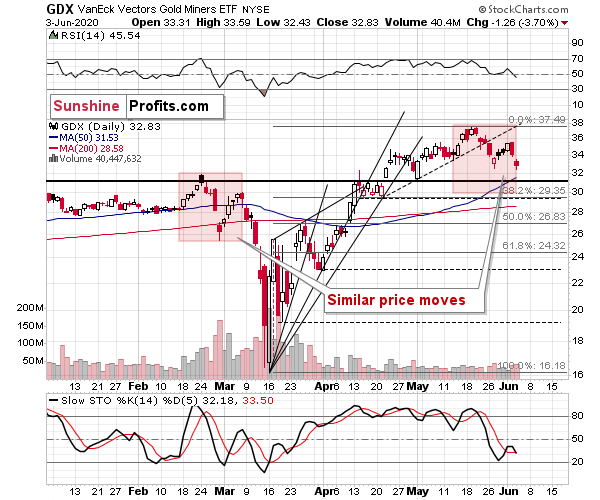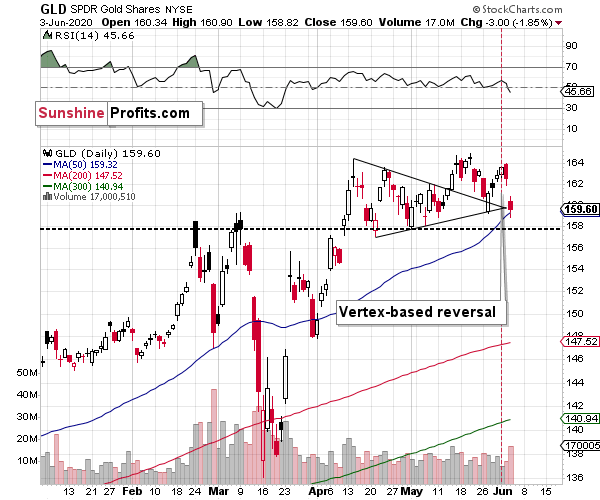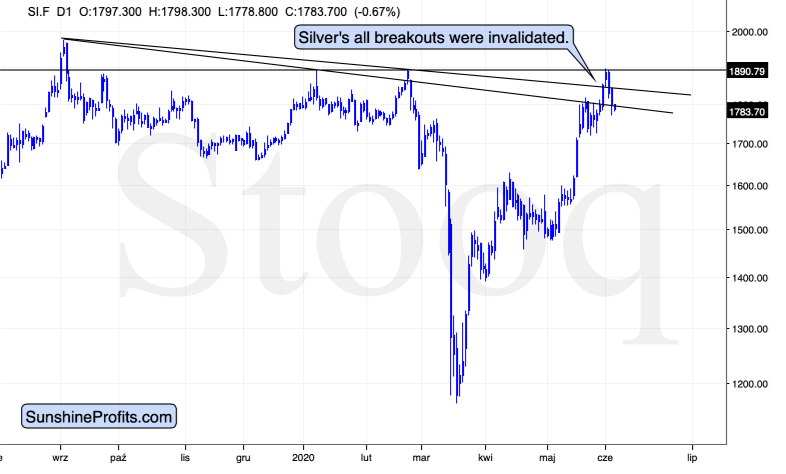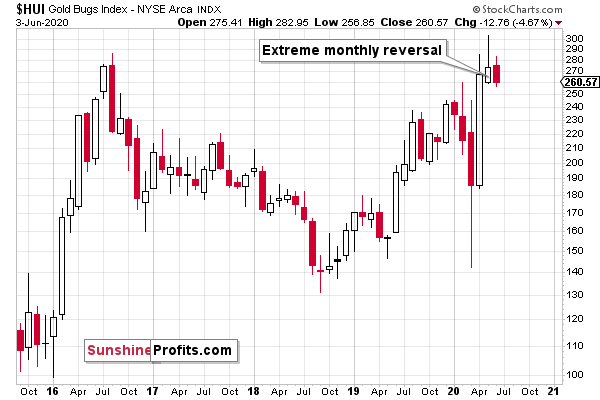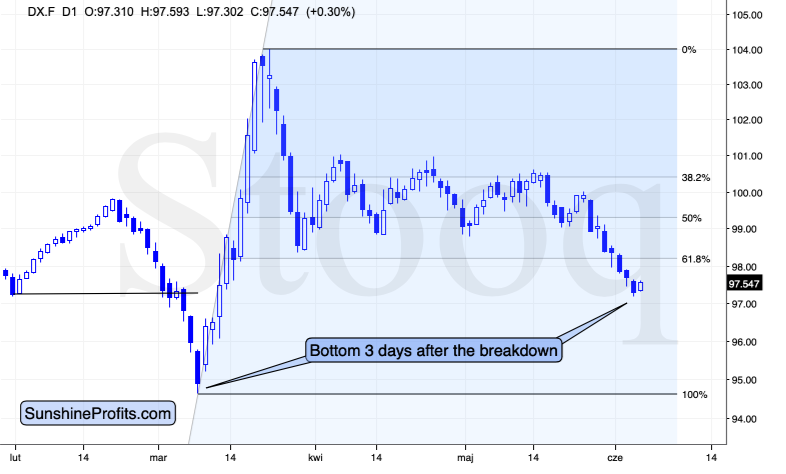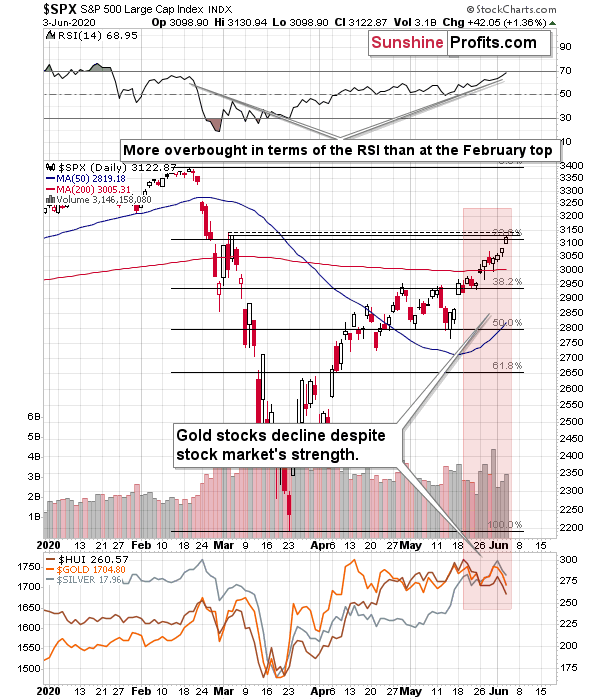Briefly: in our opinion, full (250% of the regular position size) speculative short positions in mining stocks are justified from the risk/reward point of view at the moment of publishing this Alert.
In yesterday's Gold & Silver Trading Alert, we increased the size of the speculative short positions in mining stocks by 100%, and this move became immediately beneficial. Miners plunged yesterday and they even closed below the lowest closing price of May.
Yesterday, we wrote the following:
The thing that we would like to add today is the note about similarity between the price patterns that we saw between mid-February and early March and the last few weeks. The areas marked in red are identical. As you can see the shape of the price moves is very similar, and so is the timing of the price extremes. In fact, the latter is almost identical. "Almost", as it seems the move lower started one day earlier this time.
It's just like if the PMs and miners got fed up waiting for the USD's rally and stock market's decline and are moving lower even without them. This is the perfectly bearish situation, because once we do get the above-mentioned signs, the decline is likely to simply accelerate.
The above-mentioned similarity remains intact, and the best part is that it seems that we are starting to get the turnaround signs from the USD Index and the general stock market. But before moving to that, we would like to show you what gold and silver did yesterday.
The GLD ETF declined on big volume, which confirmed the direction of the move. It didn't move below the previous lows and highs just yet. The support here is very strong as it's based on two major tops and three smaller bottoms. Breaking below this level will be a clear sign that gold is going to move much lower and traders are likely to react to it immediately. Therefore, once gold breaks below the Q1 highs, we expect it to slide relatively quickly. The initial downside target will be the late-March low of about $149 in GLD and about $1,580 in gold futures.
Miners' breakdown and weakness as well as silver' invalidation of its all recent short-term breakouts confirms the bearish narrative. The USDX confirms it too.
It all indicates that gold is indeed likely to break below the above-mentioned strong support level.
We realize that "this time is different" is usually a costly thing to say, but this time it really is different. This time, gold approached the strong support even without USD's help (and actually despite its decline) and we saw very clear bearish confirmations from mining stocks, silver, and - as we discussed on Monday - from platinum and palladium.
We have gold stocks that just formed a huge monthly reversal candlestick.
Yes, mining stocks have already declined shortly after May ended, but the size of the decline has been barely noticeable on the monthly chart where the reversal took place. Consequently, it seems that the move has only begun.
And speaking of non-PM markets, the USD Index has just moved to new intraday high.
This may seem like nothing to call home about, but it's actually the first time in 8 trading days that we saw a new intraday high. This is an early indication that the bottom for the USDX is already in. It also fits what we wrote yesterday:
In yesterday's analysis, we emphasized that the length of the current decline is very similar to the length of the February - March decline that we saw right before the big USDX run-up. We also argued that the situation is relatively similar on the fundamental front. To clarify, there are obvious differences, but the key similarity is that it's relatively clear that the Covid-19 cases are going up and the economic implications are going to be more severe than it is currently perceived in general, but the numbers don't yet reflect that. Which is probably why the USDX is still not soaring and stocks are not yet declining. Again - it's a "yet" in my view.
What we would like to add to the above today is that in March, the USDX bottomed on the third day after breaking below the previous important support (the January low). Today is also the third day when the USD Index moved below the important support in the form of the 61.8% Fibonacci retracement. It could be the case that the big run-up is just around the corner. And since gold is already declining despite the lack of USD's help, such an USDX rally would likely have a devastating effect on the precious metals sector.
So far, the move up in the USDX is tiny, but it seems to be first crack in the dam. What comes next might not be small at all.
The implications for the precious metals market are bearish.
And the stock market?
You will find more detailed stock market analysis in our Stock Trading Alerts, but in my opinion, a decline from here is likely. The S&P 500 reached a less popular, but still, a Fibonacci retracement level (78.6%) and it moved to its March highs. It's also declining in the pre-market trading.
The decline in the stock market is what would likely add fuel to the bearish fire in particular in case of silver and mining stocks.
The fact that gold miners (brown line in the lower part of the above chart represents the HUI Index) moved visibly lower despite a decisive move higher in the S&P, is already a strong bearish sign. Once stocks decline and so does gold, gold stocks are likely to truly slide.
Summary
Summing up, the very bearish situation became extremely bearish as silver's fakeout became crystal-clear and gold miners continue to show weakness to gold, and the latter is showing weakness relative to what's happening in the USD Index.
In our view, the above, plus GLD's triangle-vertex-based reversal, gold's seasonal patterns and other factors that we outlined in this week's flagship Gold & Silver Trading Alert, makes an even bigger short position justified from the risk to reward point of view. Consequently, we are increasing its size.
After the sell-off (that takes gold below $1,400), we expect the precious metals to rally significantly. The final decline might take as little as 1-3 weeks, so it's important to stay alert to any changes.
Most importantly - stay healthy and safe. We made a lot of money on the March decline and the subsequent rebound (its initial part) price moves (and we'll likely make much more in the following weeks and months), but you have to be healthy to really enjoy the results.
As always, we'll keep you - our subscribers - informed.
To summarize:
Trading capital (supplementary part of the portfolio; our opinion): Full speculative short positions (250% of the full position) in mining stocks is justified from the risk to reward point of view with the following binding exit profit-take price levels:
Senior mining stocks (price levels for the GDX ETF): binding profit-take exit price: $10.32; stop-loss: none (the volatility is too big to justify a SL order in case of this particular trade); binding profit-take level for the DUST ETF: $231.75; stop-loss for the DUST ETF: none (the volatility is too big to justify a SL order in case of this particular trade)
Junior mining stocks (price levels for the GDXJ ETF): binding profit-take exit price: $9.57; stop-loss: none (the volatility is too big to justify a SL order in case of this particular trade); binding profit-take level for the JDST ETF: $284.25; stop-loss for the JDST ETF: none (the volatility is too big to justify a SL order in case of this particular trade)
For-your-information targets (our opinion; we continue to think that mining stocks are the preferred way of taking advantage of the upcoming price move, but if for whatever reason one wants / has to use silver or gold for this trade, we are providing the details anyway. In our view, silver has greater potential than gold does):
Silver futures downside profit-take exit price: $8.58 (the downside potential for silver is significant, but likely not as big as the one in the mining stocks)
Gold futures downside profit-take exit price: $1,382 (the target for gold is least clear; it might drop to even $1,170 or so; the downside potential for gold is significant, but likely not as big as the one in the mining stocks or silver)
Long-term capital (core part of the portfolio; our opinion): No positions (in other words: cash
Insurance capital (core part of the portfolio; our opinion): Full position
Whether you already subscribed or not, we encourage you to find out how to make the most of our alerts and read our replies to the most common alert-and-gold-trading-related-questions.
Please note that the in the trading section we describe the situation for the day that the alert is posted. In other words, it we are writing about a speculative position, it means that it is up-to-date on the day it was posted. We are also featuring the initial target prices, so that you can decide whether keeping a position on a given day is something that is in tune with your approach (some moves are too small for medium-term traders and some might appear too big for day-traders).
Plus, you might want to read why our stop-loss orders are usually relatively far from the current price.
Please note that a full position doesn't mean using all of the capital for a given trade. You will find details on our thoughts on gold portfolio structuring in the Key Insights section on our website.
As a reminder - "initial target price" means exactly that - an "initial" one, it's not a price level at which we suggest closing positions. If this becomes the case (like it did in the previous trade) we will refer to these levels as levels of exit orders (exactly as we've done previously). Stop-loss levels, however, are naturally not "initial", but something that, in our opinion, might be entered as an order.
Since it is impossible to synchronize target prices and stop-loss levels for all the ETFs and ETNs with the main markets that we provide these levels for (gold, silver and mining stocks - the GDX ETF), the stop-loss levels and target prices for other ETNs and ETF (among other: UGLD, DGLD, USLV, DSLV, NUGT, DUST, JNUG, JDST) are provided as supplementary, and not as "final". This means that if a stop-loss or a target level is reached for any of the "additional instruments" (DGLD for instance), but not for the "main instrument" (gold in this case), we will view positions in both gold and DGLD as still open and the stop-loss for DGLD would have to be moved lower. On the other hand, if gold moves to a stop-loss level but DGLD doesn't, then we will view both positions (in gold and DGLD) as closed. In other words, since it's not possible to be 100% certain that each related instrument moves to a given level when the underlying instrument does, we can't provide levels that would be binding. The levels that we do provide are our best estimate of the levels that will correspond to the levels in the underlying assets, but it will be the underlying assets that one will need to focus on regarding the signs pointing to closing a given position or keeping it open. We might adjust the levels in the "additional instruments" without adjusting the levels in the "main instruments", which will simply mean that we have improved our estimation of these levels, not that we changed our outlook on the markets. We are already working on a tool that would update these levels on a daily basis for the most popular ETFs, ETNs and individual mining stocks.
Our preferred ways to invest in and to trade gold along with the reasoning can be found in the how to buy gold section. Additionally, our preferred ETFs and ETNs can be found in our Gold & Silver ETF Ranking.
As a reminder, Gold & Silver Trading Alerts are posted before or on each trading day (we usually post them before the opening bell, but we don't promise doing that each day). If there's anything urgent, we will send you an additional small alert before posting the main one.
Thank you.
Sincerely,
Przemyslaw Radomski, CFA
Editor-in-chief, Gold & Silver Fund Manager


